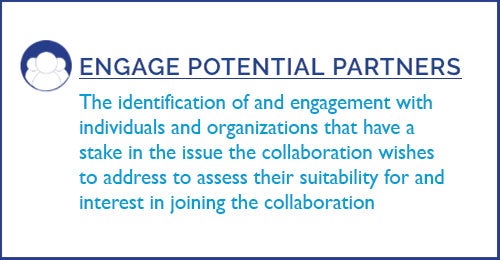Nov 11 2016 Diving Into The Intersector Toolkit: Engage Potential Partners
 We recently updated our Toolkit for Intersector Collaboration to provide even more useful advice to practitioners involved in cross-sector collaborations. Each week we’ll be profiling one of our 17 tools, with a focus on resources that can help collaborations succeed.
We recently updated our Toolkit for Intersector Collaboration to provide even more useful advice to practitioners involved in cross-sector collaborations. Each week we’ll be profiling one of our 17 tools, with a focus on resources that can help collaborations succeed.
A “go it alone” mentality may work to go fast, but in order to go far partnerships are key. Engage Potential Partners — the first tool in The Intersector Project Toolkit — represents a pivotal moment in the life of a collaboration. Carefully considering and selecting partners is crucial to ensuring that the collaboration is aware of related networks and efforts, is not overlooking important partners, builds an effective partnering culture, and has the influence and resources it needs to achieve its goals. If collaboration leaders overlook key individuals and organizations, they may find it difficult to achieve impact at the desired scale or encounter resistance to their efforts because of a lack of support or buy-in from key stakeholders.
Leaders are best equipped to select partners when they have a comprehensive understanding of the individuals and organizations — working in isolation or together — that are addressing issues related to the problem the collaboration itself will address. Practitioners can use stakeholder mapping to identify parties potentially interested in or affected by their work. The Partnering Toolbook, a comprehensive guide to partnering across sectors from The Partnering Initiative, can help a partnership identify organizations and individuals that have an interest in the issue the collaboration wishes to address and/or may be able to play a role in the collaboration. The Toolbook’s Stakeholder Mapping Tool (found on page 43) walks practitioners through performing an initial sweep of individuals and organizations, mapping their influence over and interest in the collaboration’s work, and assessing appropriate roles and level of engagement for each stakeholder identified.
The Partnership Toolkit from Collaboration Roundtable is another helpful guide for identifying and engaging partners. The Toolkit’s “Develop a Partner Profile” exercise (found on page 26) provides a set of questions intended to help the collaboration hone in on the types of individuals and organizations it needs to accomplish its aims. Other tools in the Toolkit (on pages 27-29) assist collaborations in developing an inventory of possible partners, identifying potential roles of possible partners, and gathering relevant information about possible partners. “The Partnership Toolkit” is intended to assist small agencies in working effectively with large organizations, as well as to assist community agencies in working with funders.
System mapping is another method for identifying the network of individuals and organizations that have a role or stake in an issue. Practitioners can use FSG’s System Mapping: A Guide to Developing Actor Maps, a highly detailed, 17-page resource that provides guidance on creating an actor map — a resource that provides a picture of the network of individuals and organizations that have a role or stake in some system or issue. We suggest that collaborations use their actor map to identify stakeholders, to understand their relationships to one another, and, ultimately, to reach out to potential partners. This guide is informed by FSG’s work helping foundations, businesses, non-profits, and governments accelerate progress on social change across the globe.
Once collaboration leaders understand the ecology of actors around the issue they wish to address, they can assess potential partners for suitability. The Partnering Toolbook‘s Partner Assessment Form (found on page 41) provides scaffolding for discussions with senior- and operational-level individuals at partnering organizations. It guides collaboration leaders in reviewing a series of questions on potential partners (e.g. Does the partner have reasonable standing/respect from other sectors and other key players, access to relevant information/resources/experience, and more) to identify areas of concern or where additional information is needed. The Partnership Toolkit’s Partnership Rating Tool (found on pages 30-35) is another helpful tool for addressing suitability; it helps the collaboration identify similarities and differences between itself and potential partners in areas such as organizational cultural, reputation, cultural sensitivity, skills and capabilities, and more.
The final step in engaging potential partners is to reach out and, hopefully, solidify the new partnership, beginning a sustainable collaborative initiative. Partners can use The Partnering Toolbook’s Sample Partnering Agreement (found on page 45) to formalize their decision to work together toward a common aim, recording partnering organizations’ names, the partnership’s intent, its structures and procedures, review processes, and more.
See Engage Potential Partners in our Toolkit for further discussion on this topic, questions to guide tool use, and more.
See all our full Toolkit and each of the 17 tools with enhanced discussion, questions to guide tool use, and additional resources here.
